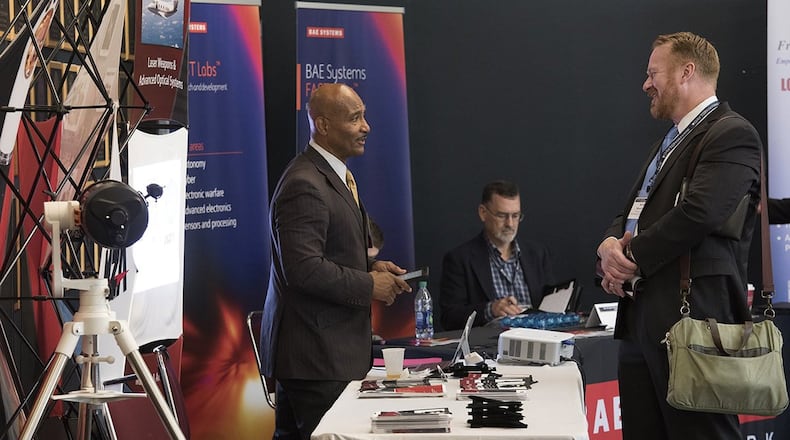“This is a dialogue not a symposium,” said Ron Dexter, vice president of Dayton Defense. “It is really for two-way conversations, and we do this by setting up breakout sessions. There are also other opportunities for back and forth dialogue between government and industry, between industry to industry and government to government.”
Maj. Gen. William T. Cooley, Air Force Research Laboratory commander, gave event opening remarks. Cooley discussed several key technologies that AFRL is focusing on that support the 2018 National Defense Strategy, including hypersonics, directed energy, autonomy, biotechnology, robotics, artificial intelligence, big data analytics and quantum computing.
Cooley emphasized that the list does not end there. AFRL is leading the strategy development for the Air Force Science and Technology 2030 enterprise, at the direction of Secretary of the Air Force Heather Wilson. As part of this effort, the lab is listening to ideas from higher education, entrepreneurs and industry across the country to discover innovative technologies for future AFRL investments.
“There are a variety of activities that we’re using to develop the strategy,” Cooley said.
He highlighted six major listening sessions hosted earlier this year at universities across the nation, with the last one at the University of Utah.
“These have been very useful events with a lot of good ideas being offered and relationship building,” Cooley said.
During his remarks, the AFRL commander highlighted the Air Force Science and Technology 2030 website (www.afresearchlab.com/2030), which allows visitors to submit ideas that will be evaluated by a panel of national experts including AFRL researchers. The most promising ideas will be presented to the Wilson in a report due in September.
“Importantly, there are two aspects to this,” Cooley said of the study. “There’s the ‘what’ and the ‘how.’ The ‘what’ refers to the specific technologies we should be investing in as part of the 2030 strategy. The ‘how’ refers to the processes by which we stay engaged with industry, academics and others to ensure that we’re staying on the leading edge of technology and finding innovative ways to apply technologies,” said Cooley.
“In a sense, one of the ‘how’s’ is this Wright Dialogue with Industry event where we’re having open dialogue with industry,” he said.
The first day of the WDI featured a keynote address by Valerie Muck, a member of the senior executive service and director of Air Force Small Business Programs at the Pentagon. She related that the vision of her office is to create a culture that looks to small businesses first for innovative, agile and affordable solutions to meet warfighter needs.
Tom Lockhart, also a member of the senior executive service, and director of the AFRL Plans and Programs and Strategic Development Planning and Experimentation directorates, provided a fiscal 2019 AFRL budget overview. Dr. Steven Rogers, AFRL’s senior scientist for Autonomy, provided the lunchtime keynote address and spoke about artificial intelligence in autonomy.
The WDI agenda also included session tracks where AFRL directors discussed the work being performed within the various technology directorates.
A keynote address given by Air Force Vice Chief of Staff Gen. Stephen W. Wilson served as the highlight for day two of the event (see sidebar story).
About the Author
